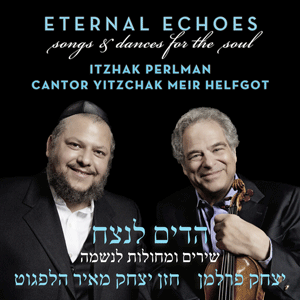Itzhak
Perlman’s playing, unmistakable from the first, interacts with the
cantorial voice mirroring it, sounding an ethereal descant over it or leading
the supporting band. His playing represents the vision of the collection, and
sets the tone for each piece. Cantor Yitzhak Meir Helfgot, musically so well
matched to Mr. Perlman, is the vocal soloist whose extraordinary voice and
abilities prove an irresistible draw. The ten selections, taken mostly from the
traditional liturgy, are sung to long-beloved tunes emblematic of the musical
palette of Ashkenazic Jewry; the refined arrangements by Hankus Netsky with
Jesse Gelber and Dmitri Slepovitch should be as appealing to the
khazones newcomer as they are familiar to the khazones
connoisseur. In its intimacy, spontaneity and captivating interpolations of
dance within song, the presentation is novel, but the album is not a novelty:
gimmickry and kitsch are wholly absent. An atmosphere arises akin to that of a
kumsitz or farbrengen, a bit informal, but spiritually
elevated. In this virtual setting, one gathers with wonderful musicians of
varied experiences and backgrounds for the sake of an outpouring of the Jewish
soul to God. Instrumentalists, who traditionally put their fiddles,
tsimbl, clarinets and horns away on the Sabbath and Jewish holy days,
play as if they were Cantor Helfgot’s meshorerim, in music whose
natural setting is the shul [synagogue], the Shabbos
[Sabbath] table, the simcha [joyous occasion] or the stage.
Of the five pieces customary for shul—T’filas
Tal [Prayer for Dew], Yism’chu [They Shall Rejoice],
R’tzay [Be Favorable], Sheyibone Bays Hamikdosh [May
the Holy Temple Be Rebuilt], Kol Nidre [All Vows]—the
R’tzay and Sheyibone Bays Hamikdosh are said daily, in
fact, multiple times a day. Yitzhak Schlossberg’s R’tzay
and Israel Schorr’s Sheyibone elaborate these prayers. Both
texts ask for God’s favor that the Temple be rebuilt and the Temple
service be restored. Schlossberg’s R’tzay pleads the case
for the acceptance of Israel’s prayers with the kind of heightened
vocalization—the krekhts—and sheer persistence that is
characteristic of khazones. Accompaniment is minimal. By contrast,
Schorr’s Sheyibone is a catchy folk-like tune punctuated by
vocal displays ascending to high B-flat, high C and a bit beyond, before
returning to the earthier main tune. This too is a pleading, but grounded in a
tune both delightful and unforgettable.
Yism’chu, a prayer of rejoicing in the Sabbath, precedes
R’tzay during the Sabbath day mussaf service. It is
sung to an old Hassidic tune that became widely used in non-Hassidic circles
thanks to recording and publication. As a prayer of rejoicing, the weight of
pleading and heightened text expression is lifted. The folk instruments come
forward and a dance in the spirit of Sabbath joy emerges to finish the piece.
Hopeful more than joyful, T’filas Tal expresses Israel’s
utter reliance upon God to draw blessings down upon the land of Israel. Dew
signifies favor, enlightenment, sweetness and abundance: a good decree. Heard
once a year on the first day of Passover, it is a composition of the legendary
cantor Yossele Rosenblatt. From its overall earnest tone, cadenza opportunities
emanate that take flight for both cantor and violinist.
There is no music on the album more famous than that of Kol Nidrei.
Arnold Schoenberg, who himself set Kol Nidrei, observed that it is not
a single melody or set composition, but a collection of melodic turns that can
be rendered in highly individual ways. It is chanted in the evening prior to
Yom Kippur [Day of Atonement]. In a real sense, Kol Nidrei is
a legal proceeding that must conclude before nightfall concerning the
nullification of vows. As stressful as a court appearance is, that stress is
never reflected in Cantor Helfgot’s voice or in the arrangement, which
prefers intimacy to monumentality. The piece begins with a prelude for the
violin based on a tune Elie Wiesel sings in his congregation. The accompaniment
is a gentle whisper as Cantor Helfgot begins. While his voice soars through the
familiar melodic turns, it never sounds strained, nor does the music ever sound
too facile. The violin returns with the High Holy Days nusach offered
in the most humble and pure fashion. The ornamented final D-flat is sufficient
for closure.
Other works include the Mizmor L’Dovid [23rd Psalm] of Ben
Zion Shenker, the great exponent of the Hassidic music of Modzitz, sung widely
at the Sabbath table, and the Zionist theatrical piece, Shoyfer shel
Moshiach of Abraham Goldfaden. The preference is for music with a
connection to Judaism in its immediacy as opposed to music that is already at a
remove from Jewish life, like the famous Oyfn Pripetchik. Electronics,
key change gimmicks and other elements of pop music are avoided. There is more
than sufficient tonal variety thanks to the keys chosen for the arrangements.
This album’s stylistic affinities lie with Schubert Lieder and
the orchestrations of Joseph Rumshinsky.
What is the album about? This is answered in the first number, A
Dudele, a song by the Hassidic master Rabbi Levi Yitzchak of Berditchev
(1740-1809). The song, like the psalm and liturgical pieces, is directed to the
Ribbono shel Olam [Master of the Universe]. What begins as a
rhetorically intensified cry for God’s attention transforms itself into
an acknowledgment of God’s omnipresence and nearness. With that
realization the rhetorical formalities fall away as a desire for closeness
becomes more insistent. It is this particular desire for closeness to the
Divine on behalf of the individual, the family, the community, the nation and
the world that ultimately speaks to a shared universal desire full of great
hope. In this respect, this album should speak to a wide audience.
Steven J. Cahn, Ph.D.
University of Cincinnati
